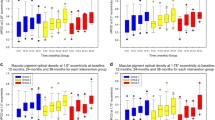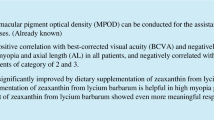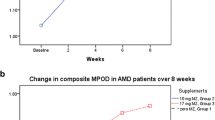Abstract
Background
Previous studies have demonstrated an increase in macular pigment optical density (MPOD) with lutein (L)-based supplementation in healthy eyes. However, not all studies have assessed whether this increase in MPOD is associated with changes to other measures of retinal function such as the multifocal ERG (mfERG). Some studies also fail to report dietary levels of L and zeaxanthin (Z). Because of the associations between increased levels of L and Z, and reduced risk of AMD, this study was designed to assess the effects of L-based supplementation on mfERG amplitudes and latencies in healthy eyes.
Methods
Multifocal ERG amplitudes, visual acuity, contrast sensitivity, MPOD and dietary levels of L and Z were assessed in this longitudinal, randomized clinical trial. Fifty-two healthy eyes from 52 participants were randomly allocated to receive a L-based supplement (treated group), or no supplement (non-treated group).
Results
There were 25 subjects aged 18–77 (mean age ± SD; 48 ± 17) in the treated group and 27 subjects aged 21–69 (mean age ± SD; 43 ± 16) in the non-treated group. All participants attended for three visits: visit one at baseline, visit two at 20 weeks and visit three at 40 weeks. A statistically significant increase in MPOD (F = 17.0, p ≤ 0.001) and shortening of mfERG ring 2 P1 latency (F = 3.69, p = 0.04) was seen in the treated group.
Conclusions
Although the results were not clinically significant, the reported trend for improvement in MPOD and mfERG outcomes warrants further investigation.



Similar content being viewed by others
References
Stephen B, Hui-Hiang K, Phil M, David H, Michael B (2000) The role of oxidative stress in the pathogenesis of age-related macular degeneration. Surv Ophthalmol 45:115–134. doi:10.1016/S0039-6257(00)00140-5
Ham WT Jr, Ruffolo JJ Jr, Mueller HA, Clarke AM, Moon ME (1978) Histologic analysis of photochemical lesions produced in rhesus retina by short-wavelength light. Invest Ophthalmol Vis Sci 17(10):1029–1035
Kaufman PL, Adler FH, Levin LA, Alm A (2011) Adler’s physiology of the eye. Elsevier Health Sciences
Snodderly DM, Auran J, Delori F (1984) The macular pigment II. Spatial distribution in primate retinas. Invest Ophthalmol Vis Sci 25:674–685
Li B, Ahmed F, Bernstein PS (2010) Studies on the singlet oxygen scavenging mechanism of human macular pigment. Arch Biochem Biophys 504(1):56–60. doi:10.1016/j.abb.2010.07.024
Mares-Perlman JA, Fisher AI, Klein R, Palta M, Block G, Millen AE, Wright JD (2001) Lutein and zeaxanthin in the diet and serum and their relation to age-related maculopathy in the third national health and nutrition examination survey. Am J Epidemiol 153(5):424–432
Seddon JM, Ajani UA, Sperduto RD, Hiller R, Blair N, Burton TC, Farber MD, Gragoudas ES, Haller J, Miller DT, Yannuzzi LA, Willett W (1994) Dietary carotenoids, vitamin A, C and E and advanced age-related macular degeneration. J Am Med Assoc 272(18):1413–1420
EDCCS Group (1993) Antioxidant status and neovascular age-related macular degeneration. Arch Ophthalmol 111(1):104–109
Nolan JM, Loughman J, Akkali MC, Stack J, Scanlon G, Davison P, Beatty S (2011) The impact of macular pigment augmentation on visual performance in normal subjects: COMPASS. Vision Res. doi:10.1016/j.visres.2010.12.016
Bone RA, Landrum JT (2010) Dose-dependent response of serum lutein and macular pigment optical density to supplementation with lutein esters. Arch Biochem Biophys 504(1):50–55. doi:10.1016/j.abb.2010.06.019
Connolly EE, Beatty S, Thurnham DI, Loughman J, Howard AN, Stack J, Nolan JM (2010) Augmentation of macular pigment following supplementation with all three macular carotenoids: an exploratory study. Curr Eye Res 35(4):335–351. doi:10.3109/02713680903521951
Stringham JM, Hammond BR (2008) Macular pigment and visual performance under glare conditions. Optom Vis Sci 85(2):82–88
Wenzel AJ, Sheehan JP, Gerweck C, Stringham JM, Fuld K, Curran-Celentano J (2007) Macular pigment optical density at four retinal loci during 120 days of lutein supplementation. Ophthalmic Physiol Opt 27(4):329–335. doi:10.1111/j.1475-1313.2007.00495.x
Trieschmann M, Beatty S, Nolan JM, Hense HW, Heimes B, Austermann U, Fobker M, Pauleikhoff D (2007) Changes in macular pigment optical density and serum concentrations of its constituent carotenoids following supplemental lutein and zeaxanthin: the LUNA study. Exp Eye Res 84(4):718–728. doi:10.1016/j.exer.2006.12.010
Schalch W, Cohn W, Barker FM, Kopcke W, Mellerio J, Bird AC, Robson AG, Fitzke FF, van Kuijk FJ (2007) Xanthophyll accumulation in the human retina during supplementation with lutein or zeaxanthin—the LUXEA (LUtein Xanthophyll Eye Accumulation) study. Arch Biochem Biophys 458(2):128–135. doi:10.1016/j.abb.2006.09.032
Rodriguez-Carmona M, Kvansakul J, Harlow JA, Kopcke W, Schalch W, Barbur JL (2006) The effects of supplementation with lutein and/or zeaxanthin on human macular pigment density and colour vision. Ophthalmic Physiol Opt 26(2):137–147. doi:10.1111/j.1475-1313.2006.00386.x
Koh HH, Murray IJ, Nolan D, Carden D, Feather J, Beatty S (2004) Plasma and macular responses to lutein supplement in subjects with and without age-related maculopathy: a pilot study. Exp Eye Res 79(1):21–27. doi:10.1016/j.exer.2004.03.001
Hammond BR, Wooten BR, Snodderly DM (1997) Individual variations in the spatial profile of human macular pigment. J Opt Soc Am A Opt Image Sci Vis 14(6):1187–1196
Bernstein PS, Khachik F, Carvalho LS, Muir GJ, Zhao D-Y, Katz NB (2001) Identification and quantitation of carotenoids and their metabolites in the tissues of the human eye. Exp Eye Res 72(3):215–223
Cangemi FE (2007) TOZAL Study: an open case control study of an oral antioxidant and omega-3 supplement for dry AMD. Biomed Central Ophthalmol 7:3. doi:10.1186/1471-2415-7-3
Richer S, Stiles W, Statkute L, Pulido J, Frankowski J, Rudy D, Pei K, Tsipursky M, Nyland J (2004) Double-masked, placebo-controlled, randomized trial of lutein and antioxidant supplementation in the intervention of atrophic age-related macular degeneration: the Veterans LAST study (Lutein Antioxidant Supplementation Trial). Optometry 75(4):216–230
Parisi V, Tedeschi M, Gallinaro G, Varano M, Saviano S, Piermarocchi S (2008) Carotenoids and antioxidants in age-related maculopathy italian study: multifocal electroretinogram modifications after 1 year. Ophthalmology 115(2):324–333. doi:10.1016/j.ophtha.2007.05.029
Richer S (1999) ARMD–pilot (case series) environmental intervention data. J Am Optom Assoc 70(1):24–36
Chew EY, Clemons TE, SanGiovanni JP, Danis R, Ferris FL, Elman M, Antoszyk A, Ruby A, Orth D, Bressler S, Fish G, Hubbard B, Klein M, Chandra S, Blodi B, Domalpally A, Friberg T, Wong W, Rosenfeld P, Agron E, Toth C, Bernstein P, Sperduto R (2013) Lutein plus zeaxanthin and omega-3 fatty acids for age-related macular degeneration The Age-Related Eye Disease Study 2 (AREDS2) randomized clinical trial. JAMA 309:2005–2015
Hood DC, Odel JG, Chen CS, Winn BJ (2003) The multifocal electroretinogram. J Neuroophthalmol 23(3):225–235
Sutter EE, Tran D (1992) The field topography of ERG components in man. 1. The photopic luminance response. Vis Res 32(3):433–446
Karanjia R, Eng KT, Gale J, Sharma S, ten Hove MW (2008) Electrophysiological effects of intravitreal Avastin (bevacizumab) in the treatment of exudative age-related macular degeneration. Br J Ophthalmol 92(9):1248–1252. doi:10.1136/bjo.2008.138800
Hood DC, Frishman LJ, Saszik S, Viswanathan S (2002) Retinal origins of the primate multifocal ERG: implications for the human response. Invest Ophthalmol Vis Sci 43(5):1673–1685
Bernstein PS, Balashov NA, Tsong ED, Rando RR (1997) Retinal tubulin binds macular carotenoids. Invest Ophthalmol Vis Sci 38(1):167–175
World Medical Association (2000) Declaration of Helsinki, ethical principles for medical research involving human subjects. 52nd WMA General Assembly, Edinburgh, Scotland
Schulz K, Altman D, Moher D, Group tC (2010) CONSORT 2010 Statement: updated guidelines for reporting parallel group randomised trials. Biomed Central Med 8(1):18
Berrow E, Bartlett H, Eperjesi F, Gibson J (2013) The effects of a lutein-based supplement on objective and subjective measures of retinal and visual function in eyes with age-related maculopathy—a randomised controlled trial. Br J Nutr 109:2008–2014
FSA (2003) Expert group on vitamins and minerals—safe upper levels for vitamins and minerals. Food standards agency
Falsini B, Piccardi M, Iarossi G, Fadda A, Merendino E, Valentini P (2003) Influence of short-term antioxidant supplementation on macular function in age-related maculopathy. A pilot study including electrophysiologic assessment. Ophthalmology 110(1):51–60
Elliott DB, Sheridan M (1988) The use of accurate visual acuity measurements in clinical anti-cataract formulation trials. Ophthalmic Physiol Opt J Br Coll Ophthalmic Opt 8(4):397–401
Arditi A, Cagenello R (1993) On the statistical reliability of letter-chart visual acuity measurements. Investig Ophthalmol Vis Sci 34(1):120–129
Bailey IL, Bullimore MA, Raasch TW, Taylor HR (1991) Clinical grading and the effects of scaling. Investig Ophthalmol Vis Sci 32(2):422–432
Lovie-Kitchin JE (1988) Validity and reliability of visual acuity measurements. Ophthalmic Physiol Opt J Br Coll Ophthalmic Opt 8(4):363–370
Reeves BC, Wood JM, Hill AR (1991) Vistech VCTS 6500 charts—within- and between-session reliability. Optom Vis Sci Off Publ Am Acad Optom 68(9):728–737
Elliott DB, Sanderson K, Conkey A (1990) The reliability of the Pelli-Robson contrast sensitivity chart. Ophthalmic Physiol Opt J Br Coll Ophthalmic Opt 10(1):21–24
Bartlett H, Stainer L, Singh S, Eperjesi F, Howells O (2010) Clinical evaluation of the MPS 9000 macular pigment screener. Br J Ophthalmol 94(6):753–756. doi:10.1136/bjo.2009.175901
Dolan F, Sandinha T, Purdy A, Parks S, Keating D (2006) Vitamin A deficiency modifies the mfERG: a case study of rod influence on the mfERG. Doc Ophthalmol 112(1):31–34. doi:10.1007/s10633-006-0002-1
Sutter EE (1991) The fast m-transform—a fast computation of cross-correlations with binary m-sequences. SIAM J Comput 20(4):686–694
Beeler P, Barthelmes D, Sutter FK, Helbig H, Fleischhauer JC (2007) Comparison of performance and patient satisfaction of two types of ERG electrodes. Klin Monatsbl Augenheilkd 224(4):265–268. doi:10.1055/s-2007-962856
Meigen T, Friedrich A (2002) The reproducibility of multifocal ERG recordings. Ophthalmologe 99(9):713–718. doi:10.1007/s00347-002-0630-0
Hood DC, Bach M, Brigell M, Keating D, Kondo M, Lyons JS, Marmor MF, McCulloch DL, Palmowski-Wolfe AM (2012) ISCEV Standard for clinical multifocal electroretinography (2011 edition). Doc Ophthalmol 124:1–13
van der Veen RL, Berendschot TT, Hendrikse F, Carden D, Makridaki M, Murray IJ (2009) A new desktop instrument for measuring macular pigment optical density based on a novel technique for setting flicker thresholds. Ophthalmic Physiol Opt 29(2):127–137. doi:10.1111/j.1475-1313.2008.00618.x
Gravetter F, Wallnau L (2000) Statistics for the behavioural sciences, 5th edn. Wadsworth, Belmont
Hahn SR (2009) Patient-centered communication to assess and enhance patient adherence to glaucoma medication. Ophthalmology 116(11):S37–S42. doi:10.1016/j.ophtha.2009.06.023
Johnson EJ, Chung HY, Caldarella SM, Snodderly DM (2008) The influence of supplemental lutein and docosahexaenoic acid on serum, lipoproteins, and macular pigmentation. Am J Clin Nutr 87(5):1521–1529
Sasamoto Y, Gomi F, Sawa M, Tsujikawa M, Nishida K (2011) Effect of 1-year lutein supplementation on macular pigment optical density and visual function. Graefe’s Arch Clin Exp Ophthalmol. doi:10.1007/s00417-011-1780-z
Nolan JM, Kenny R, O’Regan C, Cronin H, Loughman J, Connolly EE, Kearney P, Loane E, Beatty S (2010) Macular pigment optical density in an ageing Irish population: the Irish Longitudinal Study on Ageing. Ophthalmic Res 44(2):131–139. doi:10.1159/000315531
Ma L, Lin XM, Zou ZY, Xu XR, Li Y, Xu R (2009) A 12-week lutein supplementation improves visual function in Chinese people with long-term computer display light exposure. Br J Nutr 102(2):186–190. doi:10.1017/s0007114508163000
Bartlett HE, Eperjesi F (2008) A randomised controlled trial investigating the effect of lutein and antioxidant dietary supplementation on visual function in healthy eyes. Clin Nutr 27(2):218–227. doi:10.1016/j.clnu.2008.01.003
Chong EW, Kreis AJ, Wong TY, Simpson JA, Guymer RH (2008) Dietary omega-3 fatty acid and fish intake in the primary prevention of age-related macular degeneration: a systematic review and meta-analysis. Arch Ophthalmol 126(6):826–833. doi:10.1001/archopht.126.6.826
Chua B, Flood V, Rochtchina E, Wang JJ, Smith W, Mitchell P (2006) Dietary fatty acids and the 5-year incidence of age-related maculopathy. Arch Ophthalmol 124(7):981–986. doi:10.1001/archopht.124.7.981
Mohidin N, Yap M, Jacobs R (1999) Influence of age on the multifocal electroretinography. Ophthalmic Physiol Opt 19(6):481–488
Karpe G, Rickenbach K, Thomasson S (1949) The clinical electroretinogram. I. The normal electroretinogram above fifty years of age. Acta Ophthalmol 28(3):301–305
Tzekov RT, Gerth C, Werner JS (2004) Senescence of human multifocal electroretinogram components: a localized approach. Graefe’s Arch Clin Exp Ophthalmol 242(7):549–560
Nolan JM, Stack J, O’Connell E, Beatty S (2007) The relationships between macular pigment optical density and its constituent carotenoids in diet and serum. Invest Ophthalmol Vis Sci 48(2):571–582. doi:10.1167/iovs.06-0864
Erie JC, Good JA, Butz JA, Pulido JS (2009) Reduced zinc and copper in the retinal pigment epithelium and choroid in age-related macular degeneration. Am J Ophthalmol 147(2):276–282. doi:10.1016/j.ajo.2008.08.014
O’Connell O, Ryan L, O’Sullivan L, Aherne-Bruce SA, O’Brien NM (2008) Carotenoid micellarization varies greatly between individual and mixed vegetables with or without the addition of fat or fiber. Int J Vitam Nutr Res 78(4–5):238–246. doi:10.1024/0300-9831.78.45.238
Lakshminarayana R, Raju M, Keshava Prakash MN, Baskaran V (2009) Phospholipid, oleic acid micelles and dietary olive oil influence the lutein absorption and activity of antioxidant enzymes in rats. Lipids 44(9):799–806. doi:10.1007/s11745-009-3328-0
The AREDS Research Group (2001) A randomized, placebo-controlled, clinical trial of high-dose supplementation with vitamins C and E, beta carotene, and zinc for age-related macular degeneration and vision loss—AREDS Report No. 8. Arch Ophthalmol 119(10):1417–1436
Acknowledgments
Bausch and Lomb provided financial support in the form of Ph.D. funding. The sponsor had no role in the design or conduct of this research.
Author information
Authors and Affiliations
Corresponding author
Ethics declarations
Statement of human rights
All procedures performed in studies involving human participants were in accordance with the ethical standards of the institutional and/or national research committee and with the 1964 Declaration of Helsinki and its later amendments or comparable ethical standards.
Statement on the welfare of animals
This article does not contain any studies with animals performed by any of the authors.
Informed consent
Informed consent was obtained from all individual participants included in the study.
Conflict of interest
All authors certify that they have no affiliations with or involvement in any organization or entity with any financial interest (such as honoraria; educational grants; participation in speakers’ bureaus; membership, employment, consultancies, stock ownership, or other equity interest; and expert testimony or patent-licensing arrangements), or non-financial interest (such as personal or professional relationships, affiliations, knowledge or beliefs) in the subject matter or materials discussed in this manuscript.
Rights and permissions
About this article
Cite this article
Berrow, E.J., Bartlett, H.E. & Eperjesi, F. The effect of nutritional supplementation on the multifocal electroretinogram in healthy eyes. Doc Ophthalmol 132, 123–135 (2016). https://doi.org/10.1007/s10633-016-9532-3
Received:
Accepted:
Published:
Issue Date:
DOI: https://doi.org/10.1007/s10633-016-9532-3




